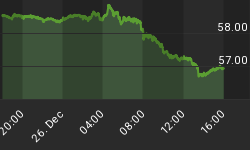The market has taken a nasty hit this past week, and as expected, investors have turned bearish. Lower prices tend to do that. Unfortunately, investors are not excessively bearish, which means there is more downside to come. There are a lot of pundits out there arguing to "buy the dip" or just "take a nibble", but what I don't think they appreciate is that there is a real potential for a bear market here. Key support levels have been shattered. I am the first guy to stand up and buy into the teeth of a nasty sell off, but sentiment isn't particularly bearish. So I will exercise patience. In addition, the broken price structure should be respected.
Before getting to the indicators, last week's comments are worth noting again: "One of the issues facing this rally since the mid- June lows has been the lack of short covering. Specifically, shorter term measures of investor sentiment, which we can get daily from the Rydex asset data, continue to show that investors are overly bullish. Too many bulls means not enough short covering to add fuel to any market rally. Any rally on whatever news is likely to fizzle out. Of course, the news is a resolution to the debt ceiling "crisis" which really isn't a crisis. And as I think about it, a resolution to the debt ceiling "crisis" isn't news either. It was going to get done. From this vantage, the real issue for the markets is the struggling economy." BINGO!
The "Dumb Money" indicator (see figure 1) looks for extremes in the data from 4 different groups of investors who historically have been wrong on the market: 1) Investors Intelligence; 2) MarketVane; 3) American Association of Individual Investors; and 4) the put call ratio. This indicator is neutral.
Figure 1. "Dumb Money"/ weekly
Figure 2 is a weekly chart of the SP500 with the InsiderScore"entire market" value in the lower panel. From the InsiderScore weekly report: "Insider trading volume picked up following the first big tranche of earnings announcements and early signs suggest that insiders may have an appetite for buying this season. These signs include: Buyers outnumbering sellers in Russell 2000 for just the seventh week of the past fifty-two; the ratio of sellers-to-buyers in the S&P 500 coming in at 2-to-1 compared to a 52-week average of 5-to-1; the number of Weekly Net Inflections (i.e. buy inflections minus sell inflections) being much higher than normal; and, the number Weekly Net Clusters (sell clusters minus buy clusters) being much lower than normal. While these are positive signs, volume will increase dramatically over the next three weeks and our strongest indicators have not triggered. Qualitatively, we would like to see stronger conviction from buyers - more CEOs and CFOs purchasing, higher dollar value buys, more cluster buys, etc."
Figure 2. InsiderScore "Entire Market" value/ weekly
Figure 3 is a weekly chart of the SP500. The indicator in the lower panel measures all the assets in the Rydex bullish oriented equity funds divided by the sum of assets in the bullish oriented equity funds plus the assets in the bearish oriented equity funds. When the indicatoris green, the value is low and there is fear in the market; this is where market bottoms are forged. When the indicator is red, there is complacency in the market. There are too many bulls and this is when market advances stall.Currently, the value of the indicator is 62.18%. Values less than 50% are associated with market bottoms. Values greater than 58% are associated with market tops.
Figure 3. Rydex Total Bull v. Total Bear/ weekly
Let me also remind readers that we are offering a 1 month FREE TRIAL to our Premium Content service, which focuses on daily market sentiment and the Rydex asset data. This is excellent data based upon real assets not opinions, and it has been very helpful as the market has been forming a top. Interestingly, I have had only a few subscribers take me up on this free offer. Amazing!
If you would like to have TheTechnicalTake delivered to your email in box, please click here: It's free!!!
















